
- Why Does Water Expand When It Freezes
- Gold Foil Experiment
- Faraday Cage
- Oil Drop Experiment
- Magnetic Monopole
- Why Do Fireflies Light Up
- Types of Blood Cells With Their Structure, and Functions
- The Main Parts of a Plant With Their Functions
- Parts of a Flower With Their Structure and Functions
- Parts of a Leaf With Their Structure and Functions
- Why Does Ice Float on Water
- Why Does Oil Float on Water
- How Do Clouds Form
- What Causes Lightning
- How are Diamonds Made
- Types of Meteorites
- Types of Volcanoes
- Types of Rocks

Types of Pollution
Pollution is defined as introducing harmful substances (solid, liquid, or gas) or any form of energy (light, heat, sound, or radioactivity) into the environment. The harmful elements that damage air, water, and land quality and cause pollution are called pollutants.
Pollution is primarily human-made, but nature can have an adverse effect also sometimes acts as a source of pollution.
What are the Different Types of Pollution: Causes and Effects
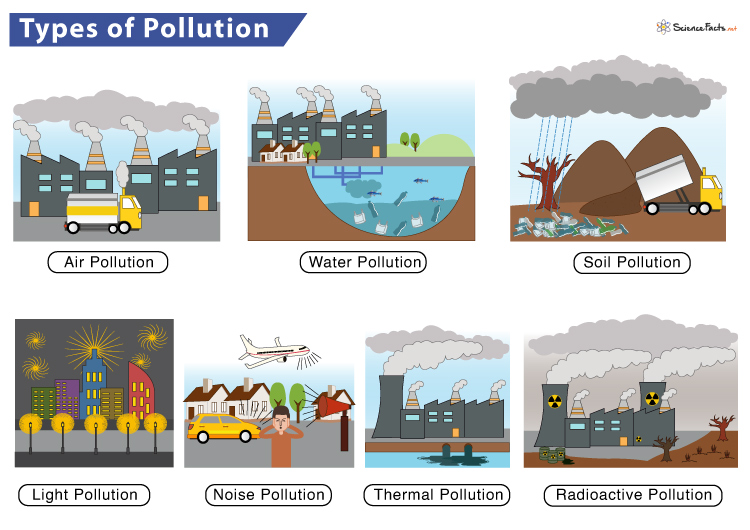
The three major types of environmental pollution are air, water, and soil. Besides these three main types, there are noise, light, thermal, and radioactive pollutions.
1. Air Pollution
The air in our atmosphere has a roughly stable chemical composition consisting of nitrogen, oxygen, argon, carbon dioxide, and trace amounts of other gases. Any change in the air composition due to the addition of unwanted gases such as sulfur dioxide, carbon monoxide, and nitrogen oxides, chemicals, particulate matter, and biological molecules is called air pollution.
Among all other types of pollution, air pollution is found to have the most diverse impact on Earth.
Sources/Causes
Air pollution can happen from both human-made (anthropogenic) and natural sources. Some of the significant sources of air pollution are given below:
- Burning of fossil fuels such as coal, oil, and natural gas
- Exhaust from automobiles and industries
- Indiscriminate cutting of trees (deforestation)
- Wildfires resulting from burning stubble and farm residues
- Release of methane from microbial decay
- Excessive discharge of greenhouse gases like carbon dioxide and nitrous oxide
- Chlorofluorocarbons (CFCs) released from aerosols sprays, refrigerants, and air conditioners
- Release volcanic ash and gases
- Respiratory disorders in humans such as asthma, lung cancer, chronic bronchitis, and other lung problems
- Formation of smog that reduces visibility
- Formation of acid rain
- Depletion of the ozone layer
- Global warming
- Hazards to wildlife
- Planting of trees (afforestation) purifies the air
- Use of renewable energy such as sunlight and wind energy and reducing dependence on nonrenewable sources such as coal, petroleum, and natural gas
- Increasing efficiency in energy usage
- Use of eco-friendly vehicles
- Cleaning of industry emissions before their release into the atmosphere
- Reducing dependence on vehicles
2. Water Pollution
Water pollution occurs when toxic pollutants and particulate matter are introduced into water bodies such as oceans, rivers, lakes, ponds, and aquifers, making them impure and toxic. These contaminants are primarily generated by human activities and sometimes by natural disasters.
Among all other types of pollution, water pollution is found to have the maximum adverse consequences on the ecosystem.
- Industrial and domestic sewage discharge
- Oil spills and natural gas leakage into water bodies from underground sites called petroleum seeps
- Social practices such as washing, bathing, and littering in water bodies and religious practices
- Agricultural runoff containing pesticides, fertilizers, herbicides, slurry, debris, and manures
- Mining and drilling sometimes make underground water contaminated
- Floods and storm carrying dust and debris to the water bodies
- Algal bloom (eutrophication) caused due to an increase in nutrients of the water bodies
- Reducing dissolved oxygen in the water bodies thus disrupting aquatic life
- Disturbing the pH and salinity of the water bodies leading to loss of aquatic life
- Increasing the risk of water-borne diseases such as hepatitis, cholera, diarrhea, and typhoid in humans
- Increasing the level of toxins and pollutants at each successive level of the food chain (biomagnification)
- Proper disposing of domestic, agricultural, and industrial wastes before releasing them into water bodies
- Using sewage treatment methods such as precipitation, ion exchange, reverse osmosis , and coagulation
- Reducing reusing, and recycling of water
- Using plants such as water hyacinth that absorbs heavy metals in areas contaminated with radioactive pollutants
3. Soil Pollution
Sometimes called land pollution, it refers to the degradation of land quality due to unwanted chemicals and other factors in the soil. Such chemicals change the soil’s chemical and biological properties, thus affecting plant growth. Green plants, being the primary producer, absorb those pollutants, which are then passed through the food chain, affecting the whole ecosystem.
Soil pollution can seep into groundwater or run off to the nearest streams and lakes, creating a vicious pollution cycle.
- Intensive farming leading to the overuse of agrochemicals such as pesticides, fertilizers, herbicides, slurry, debris, and manures
- Improper disposal of wastes from paper mills, sugar factories, petroleum, and chemical industries
- Dust particles such as silica dust
- Urban wastes consisting of garbage and rubbish materials, dried sludge, and sewage from households and commercial bodies
- Accidental oil spills from oil refineries
- Radioactive pollutants such as radium, thorium, and uranium from power plants
- Acid rain, increasing the acidity of the soil
- Deforestation that increases soil erosion causing low soil fertility
- Loss of soil fertility making it unfit for agriculture
- Adverse effect on the growth of flora and fauna in the soil
- Groundwater pollution
- Increasing the salinity of the soil, making it unfit for agriculture
- Causing respiratory problems, neuromuscular blockage, and various forms of cancer, especially lung cancer
- Causing nausea, headache, eye irritation, skin rash, and depression
- Use of organic matures instead of artificial fertilizers in agriculture
- Planting of trees (Afforestation)
- Treating solid wastes such as garbage, domestic refuse, and industrial materials before dumping them in landfills
- Recovering and recycling of materials such as plastics, cloth, and glass before dumping
4. Other Types of Pollution
1. Light Pollution
Light pollution refers to the excessive amount of light in the night sky. It occurs due to excessive, misdirected, and inefficient lighting systems by humans. It is also called photo pollution that disrupts the ecosystem by reducing the distinction between night and day.
Although light pollution seems to have a lesser impact than any other form, it is expected to have consequences similar to air or water pollution.
- Increased energy consumption through over-illumination from artificial light sources such as street lighting, domestic lighting, and garage
- Poor planning by engineers while placing street lights and signage
- Overpopulation increases electricity consumption, which increases glare
- Smog and fog due to air pollution reflect light emitted by cities, making the surrounding look much brighter
- Produce behavioral changes in animals. Nocturnal animals, who are active at night, venture out during the daytime. In contrast, diurnal animals, which are active during the day, remain active at night
- Affecting migration pattern in seasonal birds
- Difficulty for astronomers to see the stars properly
- Affecting newly hatched turtles that rely on starlight to guide them from the beach to the ocean. They often head in the wrong direction.
- Causing flowering and developmental patterns in plants
- Inducing smog by destroying nitrate radicals, helping in the dispersion of smog, and causing air pollution
- Inducing a delay in melatonin secretion in humans, which delays sleep at night
- Reducing the use of decorative lightings that produce more light and consumes more energy
- Use of covered bulbs or light that face downwards
- Switching to an LED light that reduces luminance without compromising visibility
- Proper planning during installation of street lights and signage
- Switching off street lights during daytime
- Using glare-free lighting in the outdoors
- Stopping light-trespass
2. Noise Pollution
It refers to the excessive amount of sound in the surroundings disrupting the natural balance. The acceptable amount of sound is about 60 to 65 decibels, which is the same as our everyday conversation.
Sound levels above 85 decibels are harmful depending on the duration of exposure. Noise above 140 decibels can cause permanent hearing loss. Also, the duration of exposure to the sound is found to have negative health impacts.
- Noise from heavy machines in factories, mills, and industries
- Traffic noise from vehicles (trains and buses) and airplanes
- Construction noises from boring and drilling machines
- Noise from firecrackers and loudspeakers in social events
- Household noises from television, mixer grinders, and music systems
- Loss of hearing and behavioral disorders
- Loss of focus on work leading to low work output
- Stress and Hypertension (high blood pressure)
- Lack of sleep and fatigue
- Difficulty in speech and impairment
- Hearing disorders like tinnitus
- Songbirds, such as robins, fail to communicate and find food
- Disrupting sonar, used by marine animals to communicate and locate food
- Honking in public places like hospitals, academic institutions such as schools and colleges should be banned
- Installing adequate soundproof systems in commercial buildings and hospitals
- Afforestation as trees can absorb sound
- Restricting the use of firecrackers during festivities and doing open public rallies
Apart from the types of pollution discussed, there are other forms of pollution called thermal or heat pollution and radioactive pollution .
Thermal pollution is caused due to excessive heat in the environment released from industrial power plants, deforestation, urban sprawl, and air pollution. It increases the Earth’s atmosphere causing drastic climate change and extinction of wildlife. In contrast, radioactive pollution results from accidental leakage from nuclear power plants and improper disposal of nuclear wastes. It can cause massive, long-lasting impacts such as cancer, infertility, blindness, and congenital disabilities.
Ans . Air pollution.
Ans . The seven types of pollution are air, water, soil, light, noise, thermal, and radioactive pollution.
Ans . Smog is a type of air pollution. It is a combination of fog and particulate matter that remain suspended in the air.
Ans . Carbon monoxide is a gaseous air pollutant.
Ans . Groundwater pollution can occur due to chemical spills from industries, household runoff during transportation, illegal dumping of wastes, mining operations, and atmospheric depositions.
- Pollution – Nationalgeographic.org
- Pollution: Types, Sources and Characteristics – Open.edu
- Pollution Facts & Types of Pollution – Livescience.com
- Pollution: Sources & Types – Geo.libretexts.org
- How Many Types Of Pollution Are There? – Worldatlas.com
Article was last reviewed on Friday, February 17, 2023
Related articles
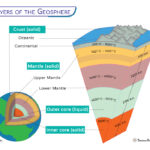
Leave a Reply Cancel reply
Your email address will not be published. Required fields are marked *
Save my name, email, and website in this browser for the next time I comment.
Popular Articles
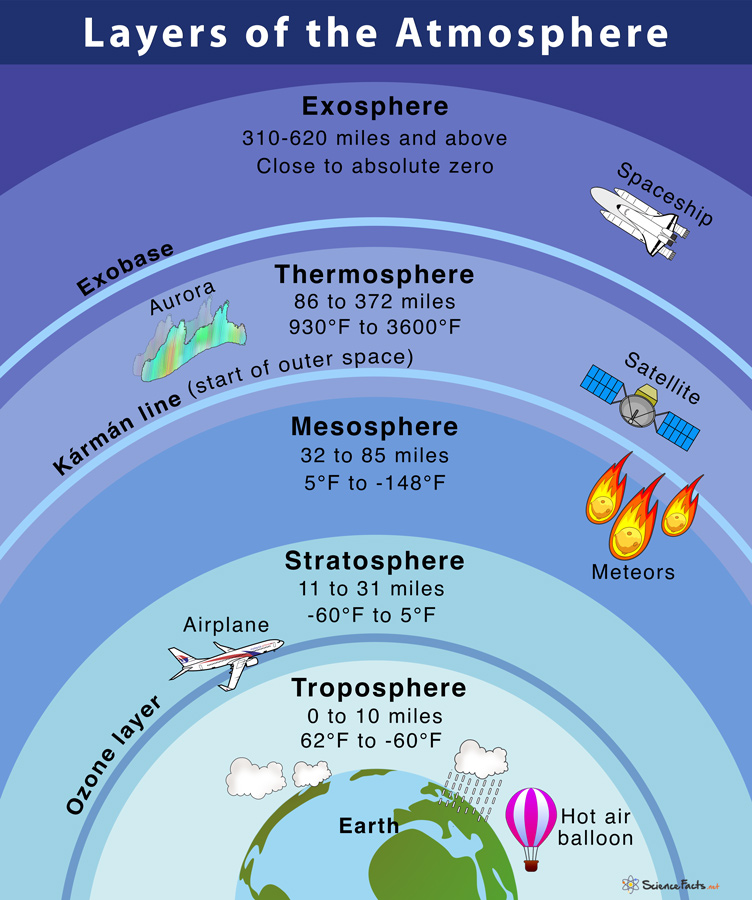
Join our Newsletter
Fill your E-mail Address
Related Worksheets
- Privacy Policy
© 2024 ( Science Facts ). All rights reserved. Reproduction in whole or in part without permission is prohibited.
ENCYCLOPEDIC ENTRY
Air pollution.
Air pollution consists of chemicals or particles in the air that can harm the health of humans, animals, and plants. It also damages buildings.
Biology, Ecology, Earth Science, Geography
Loading ...

Air pollution consists of chemicals or particles in the air that can harm the health of humans, animals, and plants. It also damages buildings. Pollutants in the air take many forms. They can be gases , solid particles, or liquid droplets. Sources of Air Pollution Pollution enters the Earth's atmosphere in many different ways. Most air pollution is created by people, taking the form of emissions from factories, cars, planes, or aerosol cans . Second-hand cigarette smoke is also considered air pollution. These man-made sources of pollution are called anthropogenic sources . Some types of air pollution, such as smoke from wildfires or ash from volcanoes , occur naturally. These are called natural sources . Air pollution is most common in large cities where emissions from many different sources are concentrated . Sometimes, mountains or tall buildings prevent air pollution from spreading out. This air pollution often appears as a cloud making the air murky. It is called smog . The word "smog" comes from combining the words "smoke" and " fog ." Large cities in poor and developing nations tend to have more air pollution than cities in developed nations. According to the World Health Organization (WHO) , some of the worlds most polluted cities are Karachi, Pakistan; New Delhi, India; Beijing, China; Lima, Peru; and Cairo, Egypt. However, many developed nations also have air pollution problems. Los Angeles, California, is nicknamed Smog City. Indoor Air Pollution Air pollution is usually thought of as smoke from large factories or exhaust from vehicles. But there are many types of indoor air pollution as well. Heating a house by burning substances such as kerosene , wood, and coal can contaminate the air inside the house. Ash and smoke make breathing difficult, and they can stick to walls, food, and clothing. Naturally-occurring radon gas, a cancer -causing material, can also build up in homes. Radon is released through the surface of the Earth. Inexpensive systems installed by professionals can reduce radon levels. Some construction materials, including insulation , are also dangerous to people's health. In addition, ventilation , or air movement, in homes and rooms can lead to the spread of toxic mold . A single colony of mold may exist in a damp, cool place in a house, such as between walls. The mold's spores enter the air and spread throughout the house. People can become sick from breathing in the spores. Effects On Humans People experience a wide range of health effects from being exposed to air pollution. Effects can be broken down into short-term effects and long-term effects . Short-term effects, which are temporary , include illnesses such as pneumonia or bronchitis . They also include discomfort such as irritation to the nose, throat, eyes, or skin. Air pollution can also cause headaches, dizziness, and nausea . Bad smells made by factories, garbage , or sewer systems are considered air pollution, too. These odors are less serious but still unpleasant . Long-term effects of air pollution can last for years or for an entire lifetime. They can even lead to a person's death. Long-term health effects from air pollution include heart disease , lung cancer, and respiratory diseases such as emphysema . Air pollution can also cause long-term damage to people's nerves , brain, kidneys , liver , and other organs. Some scientists suspect air pollutants cause birth defects . Nearly 2.5 million people die worldwide each year from the effects of outdoor or indoor air pollution. People react differently to different types of air pollution. Young children and older adults, whose immune systems tend to be weaker, are often more sensitive to pollution. Conditions such as asthma , heart disease, and lung disease can be made worse by exposure to air pollution. The length of exposure and amount and type of pollutants are also factors. Effects On The Environment Like people, animals, and plants, entire ecosystems can suffer effects from air pollution. Haze , like smog, is a visible type of air pollution that obscures shapes and colors. Hazy air pollution can even muffle sounds. Air pollution particles eventually fall back to Earth. Air pollution can directly contaminate the surface of bodies of water and soil . This can kill crops or reduce their yield . It can kill young trees and other plants. Sulfur dioxide and nitrogen oxide particles in the air, can create acid rain when they mix with water and oxygen in the atmosphere. These air pollutants come mostly from coal-fired power plants and motor vehicles . When acid rain falls to Earth, it damages plants by changing soil composition ; degrades water quality in rivers, lakes and streams; damages crops; and can cause buildings and monuments to decay . Like humans, animals can suffer health effects from exposure to air pollution. Birth defects, diseases, and lower reproductive rates have all been attributed to air pollution. Global Warming Global warming is an environmental phenomenon caused by natural and anthropogenic air pollution. It refers to rising air and ocean temperatures around the world. This temperature rise is at least partially caused by an increase in the amount of greenhouse gases in the atmosphere. Greenhouse gases trap heat energy in the Earths atmosphere. (Usually, more of Earths heat escapes into space.) Carbon dioxide is a greenhouse gas that has had the biggest effect on global warming. Carbon dioxide is emitted into the atmosphere by burning fossil fuels (coal, gasoline , and natural gas ). Humans have come to rely on fossil fuels to power cars and planes, heat homes, and run factories. Doing these things pollutes the air with carbon dioxide. Other greenhouse gases emitted by natural and artificial sources also include methane , nitrous oxide , and fluorinated gases. Methane is a major emission from coal plants and agricultural processes. Nitrous oxide is a common emission from industrial factories, agriculture, and the burning of fossil fuels in cars. Fluorinated gases, such as hydrofluorocarbons , are emitted by industry. Fluorinated gases are often used instead of gases such as chlorofluorocarbons (CFCs). CFCs have been outlawed in many places because they deplete the ozone layer . Worldwide, many countries have taken steps to reduce or limit greenhouse gas emissions to combat global warming. The Kyoto Protocol , first adopted in Kyoto, Japan, in 1997, is an agreement between 183 countries that they will work to reduce their carbon dioxide emissions. The United States has not signed that treaty . Regulation In addition to the international Kyoto Protocol, most developed nations have adopted laws to regulate emissions and reduce air pollution. In the United States, debate is under way about a system called cap and trade to limit emissions. This system would cap, or place a limit, on the amount of pollution a company is allowed. Companies that exceeded their cap would have to pay. Companies that polluted less than their cap could trade or sell their remaining pollution allowance to other companies. Cap and trade would essentially pay companies to limit pollution. In 2006 the World Health Organization issued new Air Quality Guidelines. The WHOs guidelines are tougher than most individual countries existing guidelines. The WHO guidelines aim to reduce air pollution-related deaths by 15 percent a year. Reduction Anybody can take steps to reduce air pollution. Millions of people every day make simple changes in their lives to do this. Taking public transportation instead of driving a car, or riding a bike instead of traveling in carbon dioxide-emitting vehicles are a couple of ways to reduce air pollution. Avoiding aerosol cans, recycling yard trimmings instead of burning them, and not smoking cigarettes are others.
Downwinders The United States conducted tests of nuclear weapons at the Nevada Test Site in southern Nevada in the 1950s. These tests sent invisible radioactive particles into the atmosphere. These air pollution particles traveled with wind currents, eventually falling to Earth, sometimes hundreds of miles away in states including Idaho, Utah, Arizona, and Washington. These areas were considered to be "downwind" from the Nevada Test Site. Decades later, people living in those downwind areascalled "downwinders"began developing cancer at above-normal rates. In 1990, the U.S. government passed the Radiation Exposure Compensation Act. This law entitles some downwinders to payments of $50,000.
Greenhouse Gases There are five major greenhouse gases in Earth's atmosphere.
- water vapor
- carbon dioxide
- nitrous oxide
London Smog What has come to be known as the London Smog of 1952, or the Great Smog of 1952, was a four-day incident that sickened 100,000 people and caused as many as 12,000 deaths. Very cold weather in December 1952 led residents of London, England, to burn more coal to keep warm. Smoke and other pollutants became trapped by a thick fog that settled over the city. The polluted fog became so thick that people could only see a few meters in front of them.
Media Credits
The audio, illustrations, photos, and videos are credited beneath the media asset, except for promotional images, which generally link to another page that contains the media credit. The Rights Holder for media is the person or group credited.
Illustrators
Educator reviewer, last updated.
March 6, 2024
User Permissions
For information on user permissions, please read our Terms of Service. If you have questions about how to cite anything on our website in your project or classroom presentation, please contact your teacher. They will best know the preferred format. When you reach out to them, you will need the page title, URL, and the date you accessed the resource.
If a media asset is downloadable, a download button appears in the corner of the media viewer. If no button appears, you cannot download or save the media.
Text on this page is printable and can be used according to our Terms of Service .
Interactives
Any interactives on this page can only be played while you are visiting our website. You cannot download interactives.
Related Resources
Got any suggestions?
We want to hear from you! Send us a message and help improve Slidesgo
Top searches
Trending searches

11 templates

21 templates

holy spirit
35 templates

memorial day
12 templates

17 templates

art portfolio
81 templates
Air Pollution Infographics
It seems that you like this template, free google slides theme, powerpoint template, and canva presentation template.
There are many different types of pollution and it is important to know how we can reduce the ecological impact we can cause with each of them, any help is good! If you are also environmentally conscious, we bring you this template with a collection of infographics about air pollution. Inside you can find all the necessary resources to make your content shine and stand out: tables, graphs of different types, icons, images, maps... In addition, its combination of colors in cool tones will attract the attention of your audience.
Features of these infographics
- 100% editable and easy to modify
- 31 different infographics to boost your presentations
- Include icons and Flaticon’s extension for further customization
- Designed to be used in Google Slides, Canva, and Microsoft PowerPoint and Keynote
- 16:9 widescreen format suitable for all types of screens
- Include information about how to edit and customize your infographics
How can I use the infographics?
Am I free to use the templates?
How to attribute the infographics?
Attribution required If you are a free user, you must attribute Slidesgo by keeping the slide where the credits appear. How to attribute?
Related posts on our blog.

How to Add, Duplicate, Move, Delete or Hide Slides in Google Slides

How to Change Layouts in PowerPoint

How to Change the Slide Size in Google Slides
Related presentations.

Premium template
Unlock this template and gain unlimited access


Russell Millner/Alamy
Defend Our Planet and Most Vulnerable Species
Your donation today will be triple-matched to power NRDC’s next great chapter in protecting our ecosystems and saving imperiled wildlife.
Water Pollution: Everything You Need to Know
Our rivers, reservoirs, lakes, and seas are drowning in chemicals, waste, plastic, and other pollutants. Here’s why—and what you can do to help.
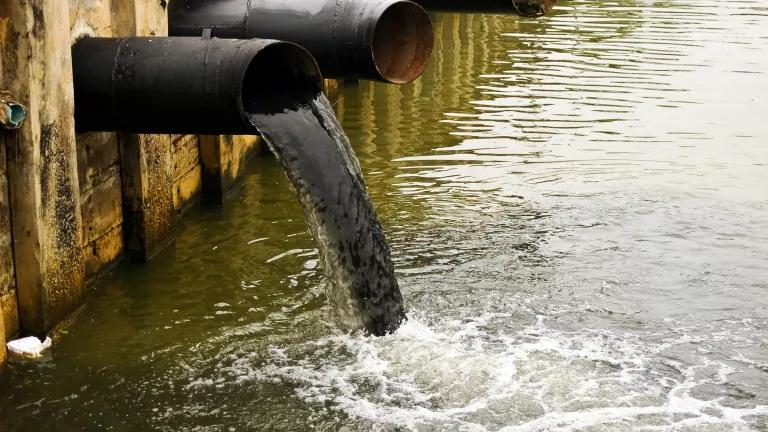
- Share this page block
What is water pollution?
What are the causes of water pollution, categories of water pollution, what are the effects of water pollution, what can you do to prevent water pollution.
Water pollution occurs when harmful substances—often chemicals or microorganisms—contaminate a stream, river, lake, ocean, aquifer, or other body of water, degrading water quality and rendering it toxic to humans or the environment.
This widespread problem of water pollution is jeopardizing our health. Unsafe water kills more people each year than war and all other forms of violence combined. Meanwhile, our drinkable water sources are finite: Less than 1 percent of the earth’s freshwater is actually accessible to us. Without action, the challenges will only increase by 2050, when global demand for freshwater is expected to be one-third greater than it is now.
Water is uniquely vulnerable to pollution. Known as a “universal solvent,” water is able to dissolve more substances than any other liquid on earth. It’s the reason we have Kool-Aid and brilliant blue waterfalls. It’s also why water is so easily polluted. Toxic substances from farms, towns, and factories readily dissolve into and mix with it, causing water pollution.
Here are some of the major sources of water pollution worldwide:
Agricultural
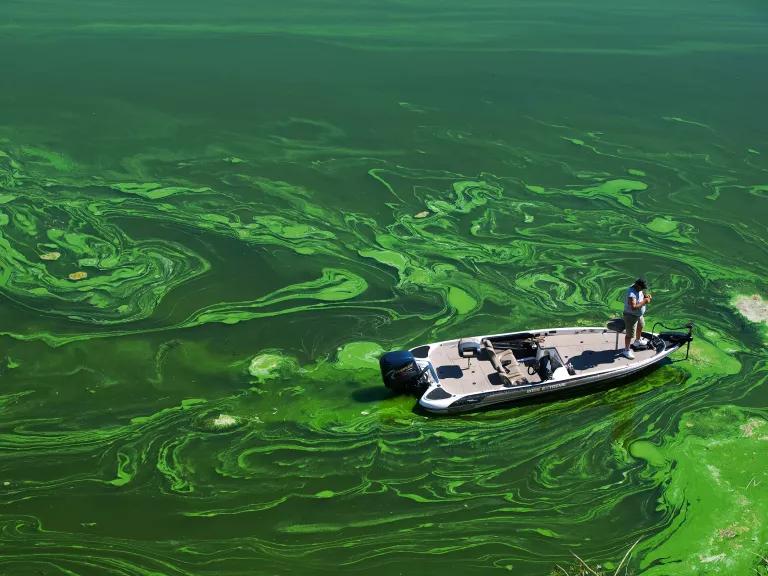
Toxic green algae in Copco Reservoir, northern California
Aurora Photos/Alamy
Not only is the agricultural sector the biggest consumer of global freshwater resources, with farming and livestock production using about 70 percent of the earth’s surface water supplies , but it’s also a serious water polluter. Around the world, agriculture is the leading cause of water degradation. In the United States, agricultural pollution is the top source of contamination in rivers and streams, the second-biggest source in wetlands, and the third main source in lakes. It’s also a major contributor of contamination to estuaries and groundwater. Every time it rains, fertilizers, pesticides, and animal waste from farms and livestock operations wash nutrients and pathogens—such bacteria and viruses—into our waterways. Nutrient pollution , caused by excess nitrogen and phosphorus in water or air, is the number-one threat to water quality worldwide and can cause algal blooms , a toxic soup of blue-green algae that can be harmful to people and wildlife.
Sewage and wastewater
Used water is wastewater. It comes from our sinks, showers, and toilets (think sewage) and from commercial, industrial, and agricultural activities (think metals, solvents, and toxic sludge). The term also includes stormwater runoff , which occurs when rainfall carries road salts, oil, grease, chemicals, and debris from impermeable surfaces into our waterways
More than 80 percent of the world’s wastewater flows back into the environment without being treated or reused, according to the United Nations; in some least-developed countries, the figure tops 95 percent. In the United States, wastewater treatment facilities process about 34 billion gallons of wastewater per day . These facilities reduce the amount of pollutants such as pathogens, phosphorus, and nitrogen in sewage, as well as heavy metals and toxic chemicals in industrial waste, before discharging the treated waters back into waterways. That’s when all goes well. But according to EPA estimates, our nation’s aging and easily overwhelmed sewage treatment systems also release more than 850 billion gallons of untreated wastewater each year.
Oil pollution
Big spills may dominate headlines, but consumers account for the vast majority of oil pollution in our seas, including oil and gasoline that drips from millions of cars and trucks every day. Moreover, nearly half of the estimated 1 million tons of oil that makes its way into marine environments each year comes not from tanker spills but from land-based sources such as factories, farms, and cities. At sea, tanker spills account for about 10 percent of the oil in waters around the world, while regular operations of the shipping industry—through both legal and illegal discharges—contribute about one-third. Oil is also naturally released from under the ocean floor through fractures known as seeps.
Radioactive substances
Radioactive waste is any pollution that emits radiation beyond what is naturally released by the environment. It’s generated by uranium mining, nuclear power plants, and the production and testing of military weapons, as well as by universities and hospitals that use radioactive materials for research and medicine. Radioactive waste can persist in the environment for thousands of years, making disposal a major challenge. Consider the decommissioned Hanford nuclear weapons production site in Washington, where the cleanup of 56 million gallons of radioactive waste is expected to cost more than $100 billion and last through 2060. Accidentally released or improperly disposed of contaminants threaten groundwater, surface water, and marine resources.
To address pollution and protect water we need to understand where the pollution is coming from (point source or nonpoint source) and the type of water body its impacting (groundwater, surface water, or ocean water).
Where is the pollution coming from?
Point source pollution.
When contamination originates from a single source, it’s called point source pollution. Examples include wastewater (also called effluent) discharged legally or illegally by a manufacturer, oil refinery, or wastewater treatment facility, as well as contamination from leaking septic systems, chemical and oil spills, and illegal dumping. The EPA regulates point source pollution by establishing limits on what can be discharged by a facility directly into a body of water. While point source pollution originates from a specific place, it can affect miles of waterways and ocean.
Nonpoint source
Nonpoint source pollution is contamination derived from diffuse sources. These may include agricultural or stormwater runoff or debris blown into waterways from land. Nonpoint source pollution is the leading cause of water pollution in U.S. waters, but it’s difficult to regulate, since there’s no single, identifiable culprit.
Transboundary
It goes without saying that water pollution can’t be contained by a line on a map. Transboundary pollution is the result of contaminated water from one country spilling into the waters of another. Contamination can result from a disaster—like an oil spill—or the slow, downriver creep of industrial, agricultural, or municipal discharge.
What type of water is being impacted?
Groundwater pollution.
When rain falls and seeps deep into the earth, filling the cracks, crevices, and porous spaces of an aquifer (basically an underground storehouse of water), it becomes groundwater—one of our least visible but most important natural resources. Nearly 40 percent of Americans rely on groundwater, pumped to the earth’s surface, for drinking water. For some folks in rural areas, it’s their only freshwater source. Groundwater gets polluted when contaminants—from pesticides and fertilizers to waste leached from landfills and septic systems—make their way into an aquifer, rendering it unsafe for human use. Ridding groundwater of contaminants can be difficult to impossible, as well as costly. Once polluted, an aquifer may be unusable for decades, or even thousands of years. Groundwater can also spread contamination far from the original polluting source as it seeps into streams, lakes, and oceans.
Surface water pollution
Covering about 70 percent of the earth, surface water is what fills our oceans, lakes, rivers, and all those other blue bits on the world map. Surface water from freshwater sources (that is, from sources other than the ocean) accounts for more than 60 percent of the water delivered to American homes. But a significant pool of that water is in peril. According to the most recent surveys on national water quality from the U.S. Environmental Protection Agency, nearly half of our rivers and streams and more than one-third of our lakes are polluted and unfit for swimming, fishing, and drinking. Nutrient pollution, which includes nitrates and phosphates, is the leading type of contamination in these freshwater sources. While plants and animals need these nutrients to grow, they have become a major pollutant due to farm waste and fertilizer runoff. Municipal and industrial waste discharges contribute their fair share of toxins as well. There’s also all the random junk that industry and individuals dump directly into waterways.
Ocean water pollution
Eighty percent of ocean pollution (also called marine pollution) originates on land—whether along the coast or far inland. Contaminants such as chemicals, nutrients, and heavy metals are carried from farms, factories, and cities by streams and rivers into our bays and estuaries; from there they travel out to sea. Meanwhile, marine debris— particularly plastic —is blown in by the wind or washed in via storm drains and sewers. Our seas are also sometimes spoiled by oil spills and leaks—big and small—and are consistently soaking up carbon pollution from the air. The ocean absorbs as much as a quarter of man-made carbon emissions .
On human health
To put it bluntly: Water pollution kills. In fact, it caused 1.8 million deaths in 2015, according to a study published in The Lancet . Contaminated water can also make you ill. Every year, unsafe water sickens about 1 billion people. And low-income communities are disproportionately at risk because their homes are often closest to the most polluting industries.
Waterborne pathogens, in the form of disease-causing bacteria and viruses from human and animal waste, are a major cause of illness from contaminated drinking water . Diseases spread by unsafe water include cholera, giardia, and typhoid. Even in wealthy nations, accidental or illegal releases from sewage treatment facilities, as well as runoff from farms and urban areas, contribute harmful pathogens to waterways. Thousands of people across the United States are sickened every year by Legionnaires’ disease (a severe form of pneumonia contracted from water sources like cooling towers and piped water), with cases cropping up from California’s Disneyland to Manhattan’s Upper East Side.
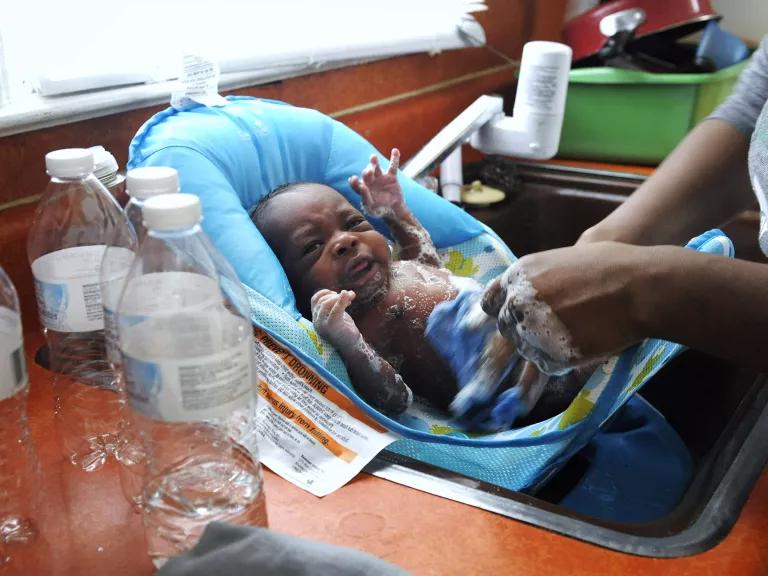
A woman using bottled water to wash her three-week-old son at their home in Flint, Michigan
Todd McInturf/The Detroit News/AP
Meanwhile, the plight of residents in Flint, Michigan —where cost-cutting measures and aging water infrastructure created a lead contamination crisis—offers a stark look at how dangerous chemical and other industrial pollutants in our water can be. The problem goes far beyond Flint and involves much more than lead, as a wide range of chemical pollutants—from heavy metals such as arsenic and mercury to pesticides and nitrate fertilizers —are getting into our water supplies. Once they’re ingested, these toxins can cause a host of health issues, from cancer to hormone disruption to altered brain function. Children and pregnant women are particularly at risk.
Even swimming can pose a risk. Every year, 3.5 million Americans contract health issues such as skin rashes, pinkeye, respiratory infections, and hepatitis from sewage-laden coastal waters, according to EPA estimates.
On the environment
In order to thrive, healthy ecosystems rely on a complex web of animals, plants, bacteria, and fungi—all of which interact, directly or indirectly, with each other. Harm to any of these organisms can create a chain effect, imperiling entire aquatic environments.
When water pollution causes an algal bloom in a lake or marine environment, the proliferation of newly introduced nutrients stimulates plant and algae growth, which in turn reduces oxygen levels in the water. This dearth of oxygen, known as eutrophication , suffocates plants and animals and can create “dead zones,” where waters are essentially devoid of life. In certain cases, these harmful algal blooms can also produce neurotoxins that affect wildlife, from whales to sea turtles.
Chemicals and heavy metals from industrial and municipal wastewater contaminate waterways as well. These contaminants are toxic to aquatic life—most often reducing an organism’s life span and ability to reproduce—and make their way up the food chain as predator eats prey. That’s how tuna and other big fish accumulate high quantities of toxins, such as mercury.
Marine ecosystems are also threatened by marine debris , which can strangle, suffocate, and starve animals. Much of this solid debris, such as plastic bags and soda cans, gets swept into sewers and storm drains and eventually out to sea, turning our oceans into trash soup and sometimes consolidating to form floating garbage patches. Discarded fishing gear and other types of debris are responsible for harming more than 200 different species of marine life.
Meanwhile, ocean acidification is making it tougher for shellfish and coral to survive. Though they absorb about a quarter of the carbon pollution created each year by burning fossil fuels, oceans are becoming more acidic. This process makes it harder for shellfish and other species to build shells and may impact the nervous systems of sharks, clownfish, and other marine life.

With your actions
We’re all accountable to some degree for today’s water pollution problem. Fortunately, there are some simple ways you can prevent water contamination or at least limit your contribution to it:
- Learn about the unique qualities of water where you live . Where does your water come from? Is the wastewater from your home treated? Where does stormwater flow to? Is your area in a drought? Start building a picture of the situation so you can discover where your actions will have the most impact—and see if your neighbors would be interested in joining in!
- Reduce your plastic consumption and reuse or recycle plastic when you can.
- Properly dispose of chemical cleaners, oils, and nonbiodegradable items to keep them from going down the drain.
- Maintain your car so it doesn’t leak oil, antifreeze, or coolant.
- If you have a yard, consider landscaping that reduces runoff and avoid applying pesticides and herbicides .
- Don’t flush your old medications! Dispose of them in the trash to prevent them from entering local waterways.
- Be mindful of anything you pour into storm sewers, since that waste often won’t be treated before being released into local waterways. If you notice a storm sewer blocked by litter, clean it up to keep that trash out of the water. (You’ll also help prevent troublesome street floods in a heavy storm.)
- If you have a pup, be sure to pick up its poop .
With your voice
One of the most effective ways to stand up for our waters is to speak out in support of the Clean Water Act, which has helped hold polluters accountable for five decades—despite attempts by destructive industries to gut its authority. But we also need regulations that keep pace with modern-day challenges, including microplastics, PFAS , pharmaceuticals, and other contaminants our wastewater treatment plants weren’t built to handle, not to mention polluted water that’s dumped untreated.
Tell the federal government, the U.S. Army Corps of Engineers, and your local elected officials that you support water protections and investments in infrastructure, like wastewater treatment, lead-pipe removal programs, and stormwater-abating green infrastructure. Also, learn how you and those around you can get involved in the policymaking process . Our public waterways serve every one of us. We should all have a say in how they’re protected.
This story was originally published on May 14, 2018, and has been updated with new information and links.
This NRDC.org story is available for online republication by news media outlets or nonprofits under these conditions: The writer(s) must be credited with a byline; you must note prominently that the story was originally published by NRDC.org and link to the original; the story cannot be edited (beyond simple things such as grammar); you can’t resell the story in any form or grant republishing rights to other outlets; you can’t republish our material wholesale or automatically—you need to select stories individually; you can’t republish the photos or graphics on our site without specific permission; you should drop us a note to let us know when you’ve used one of our stories.
Related Stories

The Smart Seafood and Sustainable Fish Buying Guide
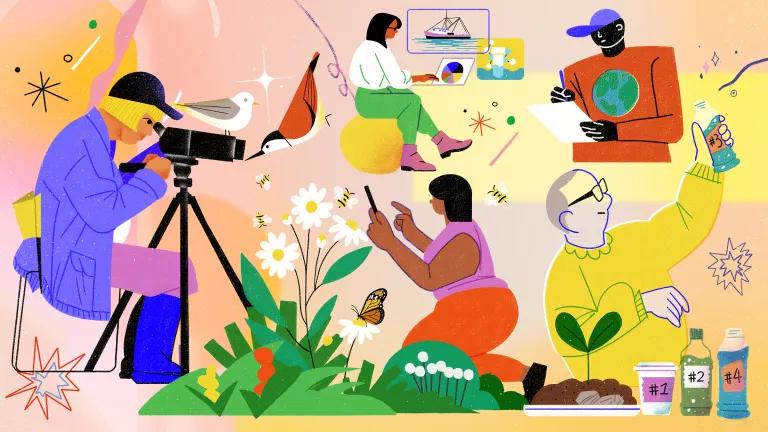
How to Become a Community Scientist
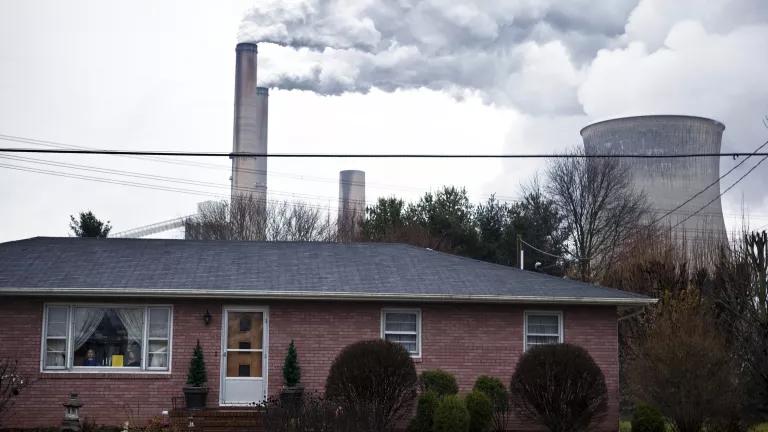
How to Start Saving the Planet in 100 Days: the Joe Biden Edition
When you sign up, you’ll become a member of NRDC’s Activist Network. We will keep you informed with the latest alerts and progress reports.
Home / Free PowerPoint Presentation Templates for Business And Google Slides / Free Air Pollution PPT Template and Google Slides
Free Air Pollution PPT Template and Google Slides
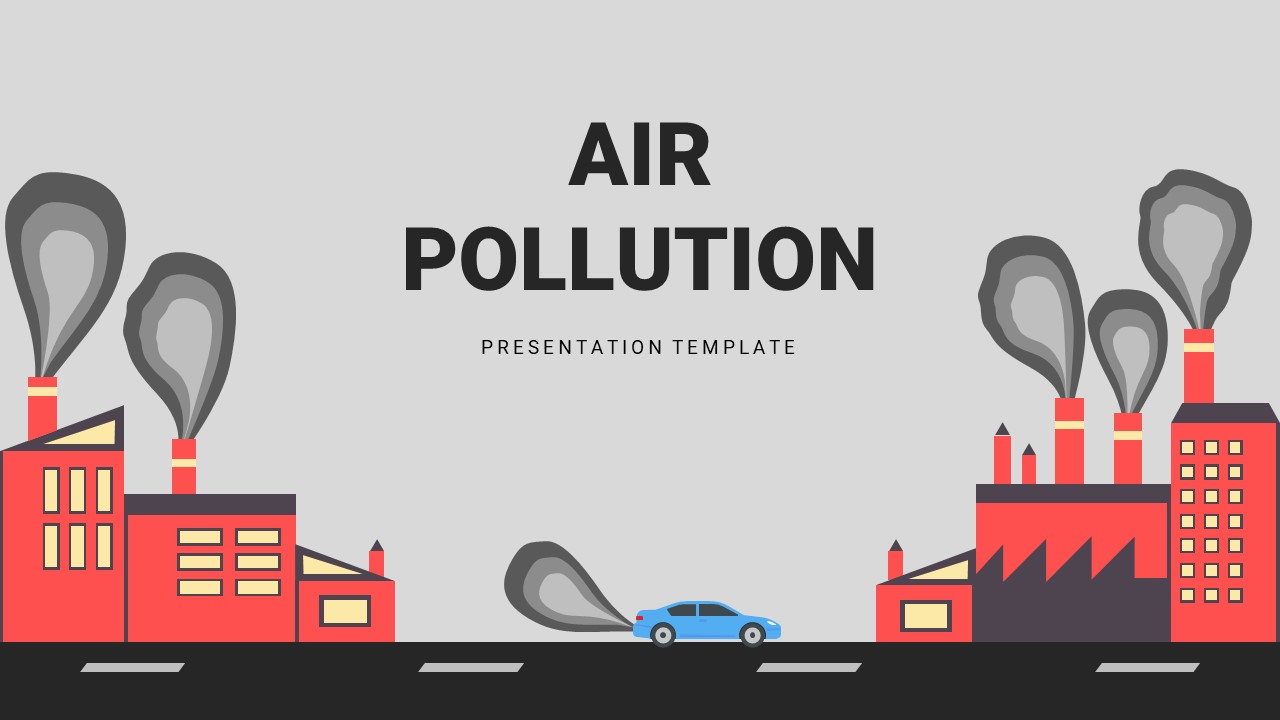
About the Template
Lay your hands on air pollution and educate your audience about how air pollutants harm human health and the environment with this free air pollution ppt template & Google slides .
Download our free air pollution Google Slides free templates and elevate your environmental presentations. This professionally designed and visually stunning template is your key to crafting a professional, impactful presentation on the pressing issue of environmental pollution.
Key Features of this Free Air Pollution PowerPoint presentation templates
- Captivating Design: Consequences of air pollution can be adverse. Our free pollution template uses interesting visuals and illustrations that make the teaching on pollution more interesting and easier to understand. It’s the perfect canvas for your message, making your presentation look clean, polished and professional.
- Environmental Focus: This pollution theme infographic template focuses on environmental conservation. This collection of infographics helps you create a presentation on environmental pollution, from its causes to its impact, you can provide a comprehensive overview of this critical issue, educating and raising awareness effectively.
- Easy to Edit: Whether you’re a seasoned presentation pro or a novice it doesn’t make a difference, our premium style awesome pollution presentation templates are editable and easy to customize allowing for easy customization to match your brand or style preferences. Change background color, and fonts, add icon, images, content and effect, etc.
- Download for Free: This creative pollution Google Slides themes and PowerPoint template is available as a free download, making it accessible to anyone committed to addressing environmental pollution. Use it to champion environmental causes and advocate for change.
This best air pollution infographic creatively picturizes the concept of air pollution and includes stunning graphics using which you can elaborate on the subject in the most visually appealing way. It’s never too late to make changes that will improve the quality of the air you breathe! So what are you waiting for? Get this unique template ppt on air pollution and start creating awesome presentations on the conservation of air.
By downloading our Free Air Pollution Google slides and PowerPoint Template, one can craft an education lesson that highlights the importance of environmental protection and educates on different types of pollution of that. Join us in the fight against environmental pollution, one compelling presentation at a time.
Explore our Free Templates library for more interesting templates.
Google Slide,PowerPoint
100% Fully Customizable
Free to use
Free Active Template Library
Free Pawer Poit Templates
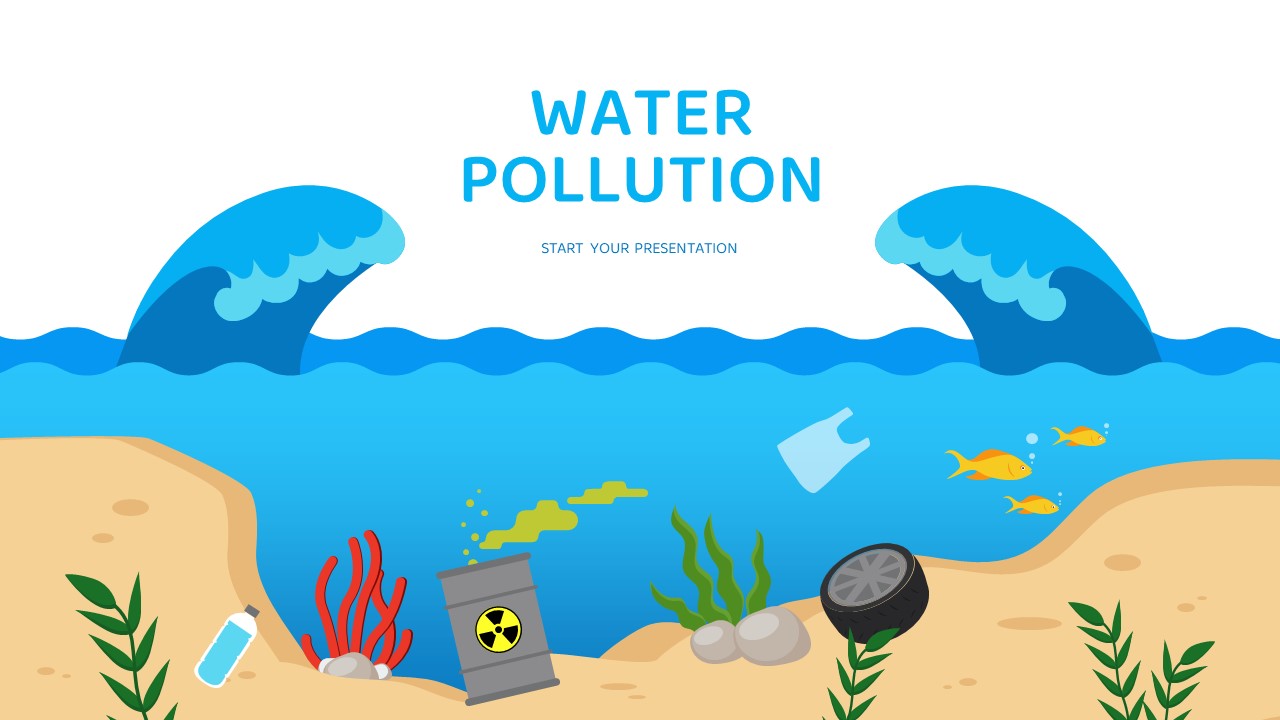
Free Water Pollution PPT Template and Google slides
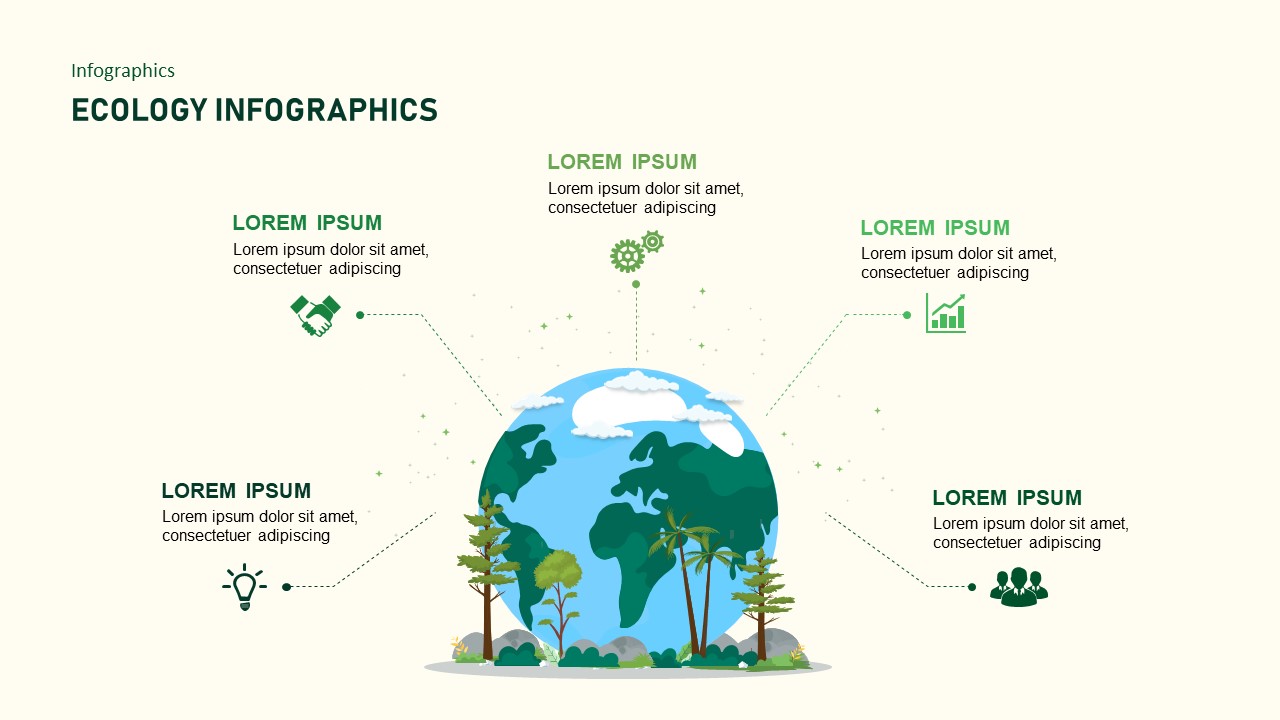
Free Ecology PPT Template and Google Slides
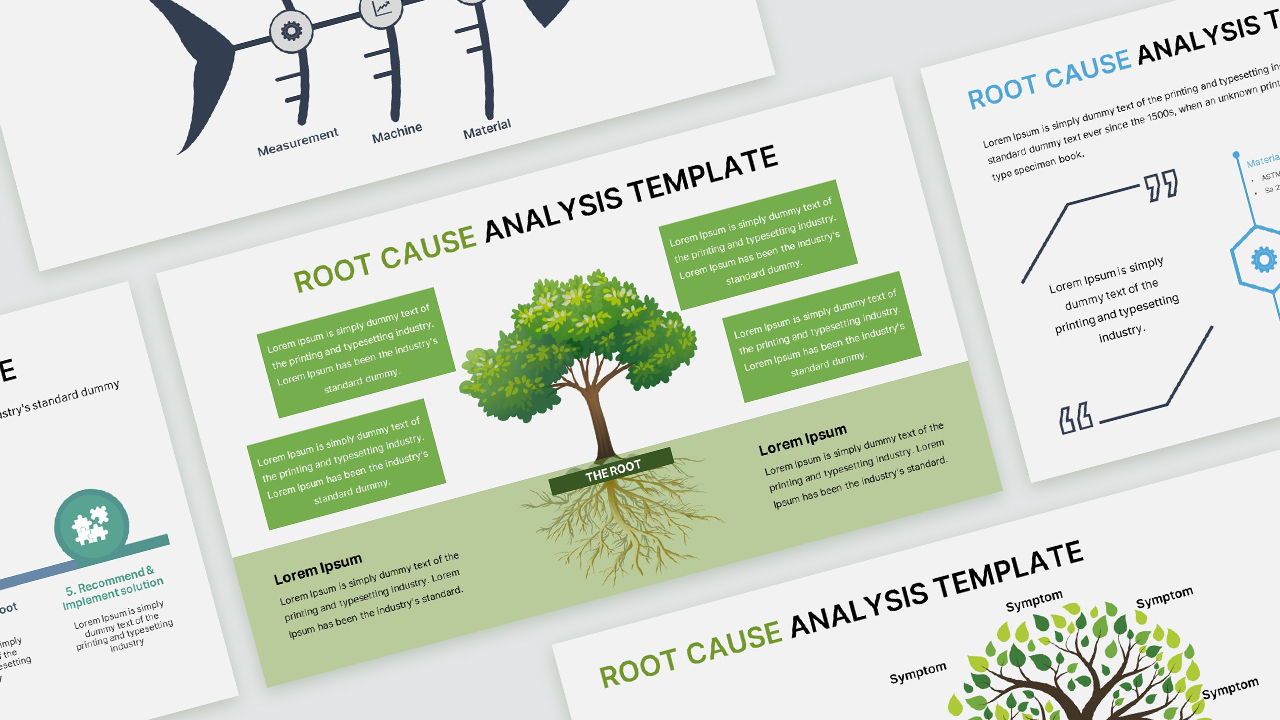
Free Root Cause Analysis Template PowerPoint & Google Slides

Free Editable Netflix PowerPoint Presentation Template and Google Slides With Animations

Free Apple Inc PowerPoint Presentation And Google Slides
Are you looking for custom presentation template designs.
It is a long established fact that a reader will be distracted by the readable content of a page when or randomised words which don’t look even slightly believable
Pete’s PowerPoint Station
- Science Index
- Math/Maths Index
- Language Arts/Literature Index
- Social Studies Index
- Holidays Index
- Art, Music, and Many More, A-Z
- Meteorology
- Four Seasons
- Pre-Algebra
- Trigonometry
- Pre-Calculus & Calculus
- Language Arts
- Punctuation
- Social Studies
- World Religions
- US Government
- Criminal Justice
- Famous People
- American History
- World History
- Ancient History
- The Middle Ages
- Architecture
- All Topics, A–Z
- Privacy & Cookie Policy
- Presentations
Free Presentations in PowerPoint format
Particle Pollution
Do Pollution Taxes Work?
Watersheds and Polluted Runoff
Pollution in the Water
Pollution and Health
Particulate Matter Air Pollution
Developing a Stormwater Pollution Plan
Soil Pollution
Air Pollution
Waste-Reduction and Pollution
Environmental Pollution and Waste
Pollution in China – What Is in the Air?
Acid Rain (several)
Pollution's Effect on Agriculture
Water Pollution
Safe Drinking Water
Noise Pollution
Threats to Coral Reefs
See Also: The Environment , Reuse/Recycle , The Water Cycle , World Problems
Pollution GAMES & Activities for Kids
Flash Presentations
For Teachers
Lots of Lessons - Pollution
Free Video Clips/Mini Movies for Kids
Free Online Science Games for Kids
Free Clipart
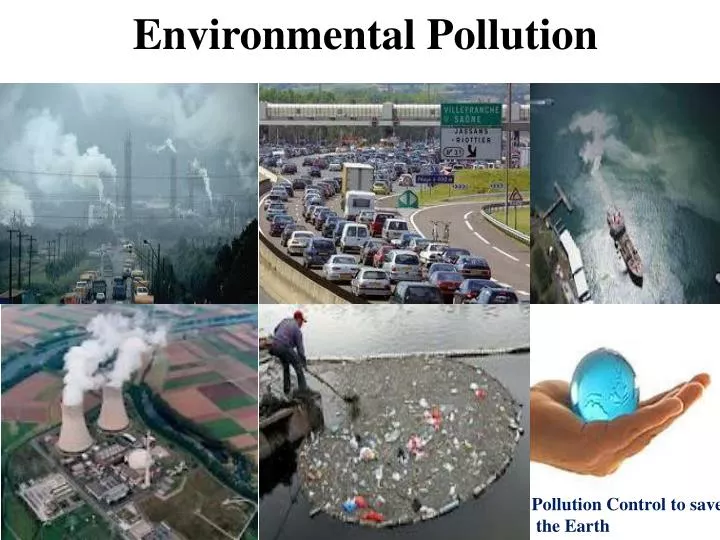
Environmental Pollution
Jul 19, 2014
2.08k likes | 6.68k Views
Environmental Pollution. Pollution Control to save the Earth. Contents. What is Environmental Pollution?. The word pollution comes from the Latin word “ pollutionem ” meaning to defile or to make dirty.
Share Presentation
- leaf abscission
- indoor air pollution
- various forms
- long chain phenolic chemicals
- heavy duty diesel vehicles
- nuclear hazards

Presentation Transcript
Environmental Pollution Pollution Control to save the Earth
What is Environmental Pollution? The word pollution comes from the Latin word “pollutionem” meaning to defile or to make dirty. For normal and healthy living a conducive environment is required by all the living beings, including humans, livestock, plants, micro-organisms and the wildlife. The favourable unpolluted environment has specific composition. When this composition gets changed by addition of harmful substances, the environment is called polluted environment and the substances polluting it are called pollutants. Environmental pollution can, therefore, be defined as any undesirable change in the physical, chemical or biological characteristics of any component of the environment (air, water, soil), which can cause harmful effects on various forms of life or property.
Types of Environmental Pollution Air Pollution Water Pollution Soil Pollution Marine Pollution Noise Pollution Thermal Pollution Nuclear Hazards
Types of Pollutants 1) On the basis of decomposition - A) Non degradable Pollutants • e.g., Aluminium cans, Hg, Pb, Cd , lonf chain phenolic chemicals, DDT. • They pass on from one biological system to another. • B) Bio-degradable Pollutants. • e.g., Domestic sewage 2) On the basis of nature - A) Physical pollutants: Heat, noise, radioactive pollutants B) Chemical Pollutants: Oxides of carbon, sulphur, nitrogen, different halogen gases. C) Biological pollutants: Bacteria, virus, fungi etc.
Types of Pollutants 3) On the basis of state - A) Solid particulate pollutant B) Liquid particulate pollutant: Leaked oil slicks oil sea water, dissolved solids, oils and grease C) Gaseous particulate pollutant: CFCs, SOx, NOx etc. 4) On the basis of their existence in nature - A) Quantitative pollutant: These are the substances which occur in the environment but becomes pollutant when their concentration reaches beyond a threshold value in the environment. Example: CO2, NO2 etc B) Qualitative pollutant: These are the substances which do not occur in the environment but are passed into it through human activity. Example: fungicides, herbicides, DDT etc
Types of Pollutants 5) On the basis of their of source of origin - A) Point source pollutant: When the origin source is point e.g., emissions from stack. B) Line source pollutant: transportation of material by conveyor belts, road rollers, run off seepage etc. C) Area source pollutant: When the source is an area e.g., blasting in mines
Air Pollution It is an atmospheric condition in which certain substances (including the normal constituents in excess) are present in concentrations which can cause undesirable effects on man and his environment. These substances include gases, particulatematter, radioactive substances etc. Gaseous pollutants include oxides of sulphur (mostly SO2,SO3) oxides of nitrogen mostly (NO and NO2 or NOx) carbon monoxide (CO), volatile organic compounds (mostly hydrocarbons) etc. “Particulatepollutantsincludesmoke, dust, soot, fumes, aerosols, liquiddroplets, pollen grains etc. Radioactive pollutants include Radon-222, iodine-131,strontium-90, plutonium-239 etc.
Classification of Air Pollutants 1) On the basis of decomposition - A) Non degradable Pollutants e.g. Aluminium cans, Hg, Pb, Cd , long chain phenolic chemicals, DDT. They pass on from one biological system to another. B) Bio-degradable Pollutants e.g. Domestic sewage. 2) On the basis of chemical composition - Organic pollutants e.g. Hydrocarbons, aldehydes, ketones, amines etc. B) Inorganic Pollutants e.g. Carbon compounds (CO and carbonates), sulphur compounds (H2S, SO2, H2SO4), nitrogen compounds (NOx, NH3), different halogen compounds (HF, HCl and metallic fluorides)
Classification of Air Pollutants Inorganic Particles (e.g. Fly ash, silica, asbestos and dusts from transport, mining, metallurgical and other industrial activities 3) On the basis of state of matter - A) Gaseous Pollutants Which get mixed with the air and do not normally settle out, e.g., CO, NOx and SO2 B) Particulate Pollutants Which comprise of finely divided soilds or liquids and often exist in colloidal state as aerosols, e.g., smoke, fumes, dust, mist, fog, smog and sprays
Sources of Air pollution 1) Natural sources • Natural contaminants usually present in the air are pollen, fungal spores, bacteria and marsh gas. • CO from the breakdown of methane • Volcanic eruptions • Forest fire release smoke and harmful trace gases • Salt spray from oceans • Dust storms. 2) Man-made sources • thermal power plants, industrial units, • vehicular emissions, • fossil fuel burning, • agricultural activities
Sources of Air pollution Thermal power plants have become the major sources of generating electricity in India as the nuclear power plants couldn’t be installed as planned. The main pollutants emitted are fly ash and SO2. Metallurgical plants also consume coal and produce similar pollutants. Fertilizer plants, smelters, textile mills, tanneries, refineries, chemical industries, paper and pulp mills are other sources of air pollution. Automobile exhaust is another major source of air pollution. Automobiles release gases such as carbon monoxide (about 77%), oxides of nitrogen (about 8%) and hydrocarbons (about 14%). Heavy duty diesel vehicles spew more NOx and suspended particulate matter (SPM) than petrol vehicle which produce more carbon monoxide and hydrocarbons.
Sources of Air pollution • Indoor Air Pollution • use of fuels like coal, dung-cakes, wood, kerosene in their kitchens (incomplete • combustion produces carbon monoxide. Coal contains varying amounts of sulphur which on burning produces sulphur dioxide. • Fossil fuel burning produces black soot. These pollutants i.e. CO, SO2, soot and many others like formaldehyde, benzene α pyrene (BAP) are toxic and harmful for health) • Smoking (pyrene is also found in cigarette smoke) • using wood as fuel for cooking inhales BAP (equivalent to 20 packets of cigarette a day) • radioactive Radon (Ra222) causes indoor air pollution in concrete buildings.
Effects of Air pollution 1) Effects on human health - • A) Irritation on the respiratory tract. • B) Irritation of eye, nose and throat. • C) Pb particulate cause convulsions, coma and even death • D) HF causes fluorosis and mottling of teeth • E) A variety of pollens can initiate asthmatic attack • F) Hg results in kidney, nerve and brain damage • G) Ni causes respiration damage. • H)Cd particulates through cigarrette smoking cause cardiovascular diseases , kidney and liver damage and even death.
Effects of Air pollution 2) Effects on plants - • SO2 bleaches the leaf surface and causes chlorosis • NO2 causes premature leaf fall and necrosis. • O3 damage leaves • PAN is responsible for suppressed growth, silvering of lower leaf surface • Ethylene induces leaf abscission, leaf epinasty • CO causes curling and premature falling of leaves.
Effects of Air pollution 3) Effect on climate - • Increase of CO2 • Global warming • Melting of ice, glaciers • Thinning of ozone layer • Penetration of UV rays
Effects of Air pollution 4) Effects on aquatic life – Air pollutants mixing up with rain can cause high acidity (lower pH) in fresh water lakes. This affects aquatic life especially fish. Some of the freshwater lakes have experienced total fish death. 5) Effect on materials – Because of their corrosiveness, particulates can cause damage to exposed surfaces. Presence of SO2 and moisture can accelerate corrosion of metallic surfaces. SO2 can affect fabric, leather, paint, paper, marble and limestone. Ozone in the atmosphere can cause cracking of rubber. Oxides of nitrogen can also cause fading of acetate, cotton and rayon fibres.
Control Measures of Air pollution • Air pollution can be minimized by the following methods: • · Siting of industries after proper Environmental Impact Assessment studies • · Using low sulphur coal in industries • · Removing sulphur from coal (by washing or with the help of bacteria) • · Removing NOx during the combustion process • · Removing particulate from stack exhaust gases by employing electrostatic • precipitators, bag-house filters, cyclone separators, scrubbers etc. • · Vehicular pollution can be checked by regular tune-up of engines, • replacement of old, more polluting vehicles, installing catalytic converters, • by engine modification to have fuel efficient (lean mixtures) to reduce CO • and hydrocarbon emissions and burning fuels slow and cooler to reduce • NOx emission (Honda Technology) • · Using mass transport system, bicycles etc. • · Shifting to less polluting fuels (hydrogen gas) • · Using non-conventional sources of energy • · By using biological filters and bio-scrubbers • · By planting more trees
- More by User
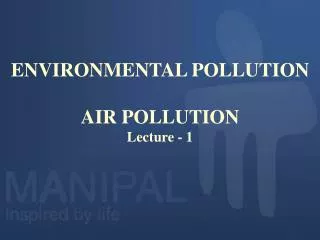
ENVIRONMENTAL POLLUTION AIR POLLUTION Lecture - 1
ENVIRONMENTAL POLLUTION AIR POLLUTION Lecture - 1. Air Necessary for Existence Colorless, odorless mixture of gases Quality of air varies in different environments Urban vs. Rural Emission of Particulate Matter from: Anthropogenic (Man-made) Sources (Industry)
2.08k views • 79 slides
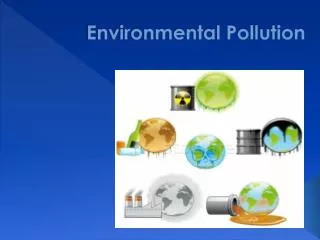
Environmental Pollution .
323 views • 11 slides

ENVIRONMENTAL POLLUTION
ENVIRONMENTAL POLLUTION . LAND & WATER POLLUTION By Dr. Frank Elwell. The Environment. THROUGHOUT HUMAN HISTORY, PEOPLE'S ACTIVITIES HAVE HAD AN ENORMOUS IMPACT ON THE PHYSICAL WORLD, AND NEW ENVIRONMENTAL PROBLEMS HAVE BEEN CREATED BY THE SOLUTIONS TO OLD ONES. The Environment.
967 views • 71 slides
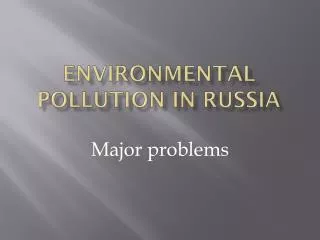
Environmental pollution in Russia
Environmental pollution in Russia. Major problems. Forest resources. Forest resources in Russia are used irrationally. When deforestation is a lot of waste. In processing lost about 20% of wood. In the forests decreased species diversity of flora and fauna . Sea pollution.
637 views • 9 slides

Food safety Environmental Pollution
Food safety Environmental Pollution. The natural environment encompasses all living and non-living things occurring naturally on Earth or some region The concept of the natural environment can be distinguished by components:
569 views • 12 slides

ENVIRONMENTAL POLLUTION. Dr VISHAL SHARMA Assoc. Prof. Botany Department Post Graduate College for Girls-11, Chandigarh. AIR POLLUTION:
596 views • 29 slides

ENVIRONMENTAL POLLUTION. Atmospheric Pollution By Dr. Frank Elwell. The Environment. THROUGHOUT HUMAN HISTORY, PEOPLE'S ACTIVITIES HAVE HAD AN ENORMOUS IMPACT ON THE PHYSICAL WORLD, AND NEW ENVIRONMENTAL PROBLEMS HAVE BEEN CREATED BY THE SOLUTIONS TO OLD ONES. The Environment.
1.33k views • 69 slides

Safety Food Environmental Pollution
Safety Food Environmental Pollution. The natural environment encompasses all living and non-living things occurring naturally on Earth or some region The concept of the natural environment can be distinguished by components:
177 views • 7 slides

ENVIRONMENTAL POLLUTION. Assoc. prof. Jānis Zaļoksnis. PEOPLE – ENVIRONMENT - POLLUTION. The past, present and potential global threat of environmental pollution and degradation is one of the main factors that has an effect on the formation of society’s environment.
1.3k views • 52 slides

ENVIRONMENTAL POLLUTION. ÇEVRE KİRLİLİĞİ. DESCRIPTION - TANIMI.
456 views • 29 slides

ENVIRONMENTAL POLLUTION. DONE BY, ARYA.M.L ANILA.G.R AISWARYA.M.J ANU.H.M X R GGHSS COTTON HILL. INTRODUCTION. Air,water,soil,human beings,animals and plants etc exists in a mutually interacting and interdependent manner. This is called the environment.
1.52k views • 8 slides

Environmental Pollution.
. Environmental Pollution. Participants. Merlin babu Hema.p R.anusuya devi. Praveena. 10E COTTON HILL GIRLS SCHOOL TVRM. INTRODUCTION. Now a day pollution is increasing . Pollution is divided into four.They are, air pollution water pollution soil pollution
683 views • 14 slides

500 views • 21 slides

Causes Of Environmental Pollution
Sewerleaks.com survey method allows clients to view large areas and discover problems that are often difficult to observe, and often continue to contaminate water bodies. Survey techniques include aerial, multi-band infrared platforms guided by autopilot over GIS data layers.
141 views • 6 slides

345 views • 8 slides

Environmental Pollution. Environmental pollution can be defined as any undesirable change in the physical, chemical or biological characteristics of any component of the environment ( air, water, soil), which can cause harmful effects on various form of life or property.
1.33k views • 99 slides

Environmental Pollution. Air Pollution. The Atmosphere. Atmospheric pressure (millibars). 0. 200. 400. 600. 800. 1,000. 120. 75. Temperature. 110. Pressure. 65. 100. Thermosphere. 90. 55. Mesopause. 80. Heating via ozone. 45. 70. Mesosphere. Altitude (kilometers).
328 views • 26 slides

ENVIRONMENTAL POLLUTION. By Miss. M. Shanthi MCA. Definition of Pollution. When Harmful Substances Contaminate the environment it is Called Pollution.
904 views • 71 slides

Environmental Pollution. What’s Environmental Pollution?. Environmental pollution in any an undesirable change in physical,chemical, or biological characteristics of any component of the environment. Forms of Environmental Pollution. *Soil contamination *Air pollution *Water pollution
340 views • 16 slides

Environmental Pollution. Petr Kristen 9.B Zš Broumovská. Overwiew. Definition of pollution Types of pollution Air pollution Water pollution Noise pollution Land pollution Radio-active pollution. Definition of pollution.
227 views • 10 slides

ENVIRONMENTAL POLLUTION. By Mrs. Vaibhavi Apte. Definition of Pollution. When Harmful Substances Contaminate the environment it is Called Pollution.
928 views • 71 slides

Pollution PPT | 30+ Best Pollution PPT Collection Download Free
Pollution ppt.
- Air Pollution PPT
- Water Pollution PPT
- Environmental Pollution PPT
- Marine Pollution PPT
- Thermal Pollution PPT
- Types of Pollution PPT
- Land Pollution PPT
- Plastic Pollution PPT
- Control of Air pollution PPT
- Air prevention and control of Pollution act 1981 PPT
- Industrial Pollution PPT
- Water Act 1974 PPT
- Groundwater pollution PPT
- Types of air pollution PPT
- Air pollution case study PPT
Noise Pollution PPT
- Photochemical Smog PPT
- Causes of Water Pollution PPT
- Indoor Air Pollution PPT
- Light Pollution PPT
- Prevention of Noise Pollution PPT
- Noise Pollution Act of 2000 PPT
- Visual Pollution PPT
- Air Quality PPT
- Effects of water pollution on human health PPT
- Soil Pollution PPT
- Oil Pollution PPT
- Ganga River Pollution PPT
- Ocean Pollution PPT
- Yamuna Pollution PPT
- Microplastic Pollution PPT

Pollution PPT
- DEFINITION OF POLLUTION
- Types of Pollution
- Air Pollution
- Water Pollution
- Noise Pollution
- Land Pollution
- Radio Active Pollution
- thermal pollution
- What is Atmosphere
- Pollution In Facts and Figures
- Pollution Control Measures
- The PPC Division
- Enforcement Mechanisms
- Causes of air pollution
- Effects of air pollution
- How to avoid air pollution
- Definition and causes and effects of water pollution
- Water pollution pictures
- How to avoid water pollution
- Noise pollution (causes, effects, and prevention)
- How to avoid noise pollution
- Definition, causes, and prevention of land pollution
- Land pollution pictures
Air pollution PPT
- What is air
- List of major air pollutants
- Sources and effects of air pollutants
- What is air pollutants?
- Six major air pollutants
- Major sources of pollutants
- Greenhouse gases
- What is air pollution
- Wildlife affected by air pollution
- Ozone layer
- Greenhouse effect
- Global warming
- Air problems caused by incineration of waste materials
- Controlling air pollution
Water pollution PPT
- Human and natural pollutants
- Sources of water pollution
- How do we measure water quality?
- Quantitative water quality tests
- Qualitative water tests
- What are some indicator species of water pollution
- Is the water safe to drink?
- What have developed countries done to reduce stream pollution
- What have developed countries done to reduce stream pollution
- Who reports on drinking water
- Clean water act 1972
- Safe water drinking act 1974
- Water purification
- What is water pollution?
- Types of water pollution
- Causes of water pollution
- Effects of water pollution
- What you can do
- Classification of water pollutant
- Common water-borne diseases
Water act 1974 PPT
- Introduction
- Salient provisions of water act (1974)
- Objectives & scope
- Powers and functions of boards
- Prevention and control of water pollution
- Penalties and procedure
- Miscellaneous
- Application and commencement
- Functions of the central board (sec. 16)
- Functions of the state board
- Ganga action plan ( gap)
- Water quality board actions
Environmental pollution PPT
- Degradable pollution
- Non-degradable pollution
- Types of pollution ( noise,air,water,land ,soil,thermal,nuclear)
- Air pollution
- Composition of air
- Types of pollutants
- Sources of air pollution
- Ozone depletion
- Water pollution ( meaning, types, definition, sources, causes and control and measures)
- Soil pollution
- Causes of soil degradation
- Marine pollution
- Causes, effects, control, and measure of marine pollution
- Control measures for oil pollution
- Noise pollution
- Levels of noise and vibration
- Decibel levels of common sounds DB
- Ambient noise levels DB
- Safe time exposure in DB
- Effects of noise pollution
- Control techniques
- Thermal pollution
- Nuclear hazards
- Effects of nuclear pollution
- Control measures
- Role of an individual in prevention of pollution
Environmental pollution PPT 2
- Types of pollution
- Water pollution
- Municipal wastewater
- Industrial waste
- Inorganic pollutants
- Organic pollutants
- Agricultural wastes
- Consequences of air pollution
- Land pollution
- Causes of land pollution
- Sources of noise pollution
- Solutions for noise pollution
- Ways to stop pollution
- Global warming and the greenhouse effect
- Difference between global warming and the greenhouse effect
- Some proof of global warming
Light pollution PPT
- What is light pollution?
- Types of light pollution
- Consequences
- Causes effect solution
Photochemical smog PPT
- Photochemical smog
- Air pollutant
- How photochemical smog is formed
- The process involving the formation of photochemical smog
- Effect on human health and plants
- Sources and effect of photochemical smog
- Factors affecting the formation of photochemical smog
- Mitigation measures for photochemical smog
- How to save the environment by preventing smog
Plastic pollution ppt
- What is pollution?
- What is plastic?
- What is plastic pollution?
- History of plastic
- Plastic pollution
- Chemicals in plastic
- Types of plastic products
- Sources of plastic pollution
- Causes of plastic pollution
- Effects of plastic pollution
- Solutions to plastic pollution
- Steps taken by govt
- Initiatives on plastic pollution
- Case studies
- Ways to mitigate plastic pollution
- Scary facts about plastic
Marine pollution PPT
- Types of marine pollution
- Causes & effects of marine pollution
- Prevention and control
- What is a pollution?
- What is marine pollution??
- Causes of marine pollution
- Major impacts of marine pollution
- The health of marine life
- Some examples of marine pollution
- Ways of pollutant inputs
- Human impacts on marine environments
- How to protect marine life?
- Oil pollution
- Garbage pollution
- Accidental loss or discharge of fishing gear
- Plan to reduce and store your garbage
- Garbage waste management onboard shore facilities
- Marine pollution threats and biodiversity conservation
- Ocean world
- Marine life and resources
- Marine ecosystem
- Marine biodiversity
- Marine pollution threats
- Pollutants types & sources
- Impact of marine pollution
- Coastal ecology
- Coastal regulation zone (crz)
- Aquaculture: the blue revolution?
- How to solve environmental pollution
- Role of marine biotechnology on environmental pollution
- Suggestions to protect marine environments
- World environmental day- June 5
- Policies and acts for the protection
Thermal pollution PPT
- Diagramatic representation
- Causes of thermal pollution
- Effects of thermal pollution
- Control of thermal pollution
- The Bentley manufacturing company
- Freeze fish breeding in Macquarie river
- Thermal pollution and the Hudson river
- Impacts of thermal pollution
- Thermal pollution causes and consequences
Land pollution PPT
- What is land pollution?
- Causes of land pollution
- Effects of land pollution
- Prevention of land pollution
- Solutions for land pollution
- WHAT IS NOISE POLLUTION
- Health Effects
- Sources of Noise Pollution
- Solutions for Noise Pollution
Agricultural pollution PPT
- What is agricultural pollution
- Types of agricultural pollution
- Main causes of agricultural pollution
- Effects of agricultural pollution
- Challenges of agricultural pollution
- Ways to reduce agricultural pollution
- Types of the mechanism of agricultural pollution
- Leaching and groundwater poisoning
- Water runoff
- Eutrophication
- Challenges or managements problems of agricultural pollution
- Prevention and techniques of agriculture pollution
- A figure showing irrigation drainage
Agriculture water pollution PPT
- Agriculture as a cause
- Sources of awp
- Impacts
Pollution and EVS PDF Books and Notes ( 4+ downloadable PDF) Pollution Handmade Assignment and Project PDF Pollution and EVS Project Videos Collection ( 20 + videos)
Similar Posts
💁Hello Friends, If You Want To Contribute To Help Other Students To Find All The Stuff At A Single Place, So Feel Free To Send Us Your Notes, Assignments, Study Material, Files, Lesson Plan, Paper, PDF Or PPT Etc. - 👉 Upload Here
अगर आप हमारे पाठकों और अन्य छात्रों की मदद करना चाहते हैं। तो बेझिझक अपने नोट्स, असाइनमेंट, अध्ययन सामग्री, फाइलें, पाठ योजना, पेपर, पीडीएफ या पीपीटी आदि हमें भेज सकते है| - 👉 Share Now
If You Like This Article, Then Please Share It With Your Friends Also.
Bcoz Sharing Is Caring 😃

- [1000+] B.Ed Lesson Plans
- B.Ed Practical Files and Assignments
- B.Ed Books and Notes PDF
- B.Ed Files Pics and Charts Collection
- BEd Model / Sample and Previous Year Papers
- All Subject Lesson Plans for Teachers
Post a Comment
Please Share your views and suggestions in the comment box
Contact Form

IMAGES
VIDEO
COMMENTS
Types of pollution - Download as a PDF or view online for free ... This is a presentation related to Pollution, types of pollution and all the causes for the pollution in the environment. This presentation will be really helpful for the school kids to understand the basic information about Pollution Pollution Presentation.
Pollution is the introduction of harmful materials into the environment. These harmful materials are called pollutants. Pollutants can be natural, such as volcanic ash. They can also be created by human activity, such as trash or runoff produced by factories. Pollutants damage the quality of air, water, and land.
Pollution is defined as introducing harmful substances (solid, liquid, or gas) or any form of energy (light, heat, sound, or radioactivity) into the environment.The harmful elements that damage air, water, and land quality and cause pollution are called pollutants. Pollution is primarily human-made, but nature can have an adverse effect also sometimes acts as a source of pollution.
pollution, the addition of any substance ( solid, liquid, or gas) or any form of energy (such as heat, sound, or radioactivity) to the environment at a rate faster than it can be dispersed, diluted, decomposed, recycled, or stored in some harmless form. The major kinds of pollution, usually classified by environment, are air pollution, water ...
Pollution is the introduction of contaminants into the natural environment that cause adverse change. [1] Pollution can take the form of any substance (solid, liquid, or gas) or energy (such as radioactivity, heat, sound, or light). Pollutants, the components of pollution, can be either foreign substances/energies or naturally occurring ...
Pollution Presentation templates There's only one planet Earth, that's for sure. Help raise awareness about climate change and its effects on the environment by creating presentations for Google Slides or PowerPoint with our templates. ... Use our infographics to showcase the damages caused by plastic waste, the different types of pollution ...
Air pollution consists of chemicals or particles in the air that can harm the health of humans, animals, and plants. It also damages buildings. Pollutants in the air take many forms. They can be gases, solid particles, or liquid droplets. Sources of Air Pollution Pollution enters the Earth's atmosphere in many different ways. Most air pollution is created by people, taking the form of ...
Free Google Slides theme, PowerPoint template, and Canva presentation template. There are many different types of pollution and it is important to know how we can reduce the ecological impact we can cause with each of them, any help is good! If you are also environmentally conscious, we bring you this template with a collection of infographics ...
This informative Types of Pollution PowerPoint provides an overview of the five main types of pollution. The PowerPoint explores air, land, water, light and noise pollution. This can be used to introduce the topic and to engage children in discussion about the impact of pollution on the environment, humans and wildlife. This Types of Pollution display poster can be used as an initial ...
Water pollution occurs when harmful substances—often chemicals or microorganisms—contaminate a stream, river, lake, ocean, aquifer, or other body of water, degrading water quality and ...
Thank you to Coleen McKellar, Biology and General Sciences Teacher, Crocus Plains Regional Secondary School, Brandon, Manitoba for sharing this resource she has developed. What are the 8 major types of water pollution? Biodegradable waste, Nutrients, Heat, Sedimentation, Chemicals, Radioactive pollutants, Medical, Microbiological.
By downloading our Free Air Pollution Google slides and PowerPoint Template, one can craft an education lesson that highlights the importance of environmental protection and educates on different types of pollution of that. Join us in the fight against environmental pollution, one compelling presentation at a time.
water pollution, the release of substances into subsurface groundwater or into lakes, streams, rivers, estuaries, and oceans to the point that the substances interfere with beneficial use of the water or with the natural functioning of ecosystems. In addition to the release of substances, such as chemicals, trash, or microorganisms, water ...
For Teachers. Lots of Lessons - Pollution. Free Video Clips/Mini Movies for Kids. Free Online Science Games for Kids. Free Clipart. Pete's PowerPoint Station is your destination for free PowerPoint presentations for kids and teachers about Pollution, and so much more.
Effects of Air pollution 3) Effect on climate - • Increase of CO2 • Global warming • Melting of ice, glaciers • Thinning of ozone layer • Penetration of UV rays. Effects of Air pollution 4) Effects on aquatic life - Air pollutants mixing up with rain can cause high acidity (lower pH) in fresh water lakes. This affects aquatic life ...
ppt about pollution. 289 uses. jamila. Pollution on Earth. It's a ppt ws. I p. 5071 uses. damarisjoan. Types of Pollution. I use this presentat. 1249 uses. ria2. pollution causes and. powerpoint presentat. 1738 uses. SuzanyStock. How we can stop poll. Start the class by a. 321 uses. CNeyraF. POLLUTION IN THE WOR.
This presentation gives the complete detail of air, air pollution, air pollutants and their types, each pollutant in detail and its causes and effects, acid rain, methods of prevention,smog,acidification,indoor pollution and so on.
If you are searching for Pollution PPT.Then this is the right place. Here you will get more than 30 + PPT Powerpoint presentation on Pollution on all the topics related to pollution and the environment which you can easily download. Note: Because we have given more than 30 PPT in one place. So It may take time to open the preview of all the PPTs.